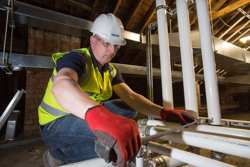Check in to increased hotel comfort and efficiency with good pipework design

Dave Lancaster discusses why hotel pipework specification should prioritise both the guest experience and the hotel’s operational considerations, including speed of installation, risk and cost.
A hotel’s plumbing may be a much lower selection criterion than the size of the bed or the interior décor, but it is no less vital to comfort and the guest experience.
 |
| The installer can fit the hot water, drinking water and heating system pipework with far fewer joints using flexible PE pipes. |
While not every guest will take advantage of the spa, the bar or the room service facilities, few will leave without using the plumbing. A negative experience – whether it’s poor water pressure in the shower or a rude awakening from clanging pipework – will influence the guest’s decisions about returning or recommending the establishment.
Flexibility and flow rate
One of the biggest challenges for hotels is maintaining water pressure and temperature to all guest rooms at all times. The internal surface of the pipe has a significant part to play in this, with a smooth surface helping to prevent a loss of head and supporting improved flow rates. In traditional copper piping installations, the need for multiple soldered joints can impair flow rates as the surface is not smooth at the join and the rigid nature of the pipe material means that a large number of joints is usually required.
Conversely, a flexible PE (polyethylene) pipe system enables the installer to fit the hot water, drinking water and heating system pipework with far fewer joints because the flexible nature of the material allows the pipe to be bent and shaped to fit around obstacles and into the required routes for the service voids and risers. Indeed, even MLC pipe (Multi-Layer Composite), which features an aluminium tube with an inner and outer-layer of PE, offers excellent flexibility, thereby requiring few joints and, like PE pipe, it also avoids the clanking and knocking sounds that generate so many guest complaints in hotels.
 |
|
Pipework infrastructure design is critical in managing the specific safety considerations of hotels. |
Of course, some joints will be required in any installation but, by using press fit, push fit or modular jointing methods instead of soldering, the jointing process is both more robust and provides a joint that is 100% reviewable once complete, safeguarding against joint detachment and the risk of significant leaks or system failure.
Safer and more versatile
With flame-free installation, MLC and PE pipe also offer safer options for hotel refurbishment schemes. For example, the recent Principal London refurbishment we supplied in Bloomsbury was specified with MLC pipe for the hot, cold and heating water risers and the main distribution infrastructure. To take the main water distribution to individual guest rooms and facilities, a PE pipe was specified for the remainder. This helped to maximise the flow rates, while taking up minimal space in the service void and reducing risk to the historic building through flame-free installation and minimised joints.
Thanks to their increased flexibility, reduced number of joints and rapid jointing methods, MLC and PE pipe systems are also faster to install, which can help hotels schemes to complete on time and overcome labour shortages.
 |
| Push fit jointing offers a robust and reviewable process that safeguards against leaks in the future. |
For modular hotel construction and pre-fabricated pods, MLC is usually the preferred choice due to the enhanced flexibility and reduced joints its offers. With some specifiers insisting on ‘joint-free’ plumbing behind any stud wall or in the ceiling void.
Fewer joints also means less vulnerability to leaks and a smooth internal surface reduces the risk of calcification, which can eventually reduce the internal diameter of a traditional pipe in hard water areas, affecting flow rates. Meanwhile, reduced maintenance requirements for PE and MLC pipe installations ensure a longer service life, with lower operational costs, and their enhanced thermal efficiency reduces heat loss to drive down energy output while maintaining higher water temperatures.
Better by design
Selecting the right material is vital for hotel pipework installations but the design of the flow and return configuration also plays an important role in delivering sufficient water pressure. Pipework infrastructure design is also critical in managing the specific safety considerations of hotels, particularly those that could experience low occupancy rates at specific times of year or days of the week, which can lead to issues with stagnant water and bacteria.
 |
|
Pipework impacts on customer comfort, which is a top priority for establishments like the Hotel Russell. |
Only by consulting with a supply chain that truly understands the challenges of hotel environments can the heating and plumbing sector ensure an installation addresses the buildability challenges of rapid installation, answers the hotel’s requirements for cost management, low maintenance and operational efficiency, and offers guests enhanced comfort and safety during their stay.
Dave Lancaster is applications specialist at Uponor







